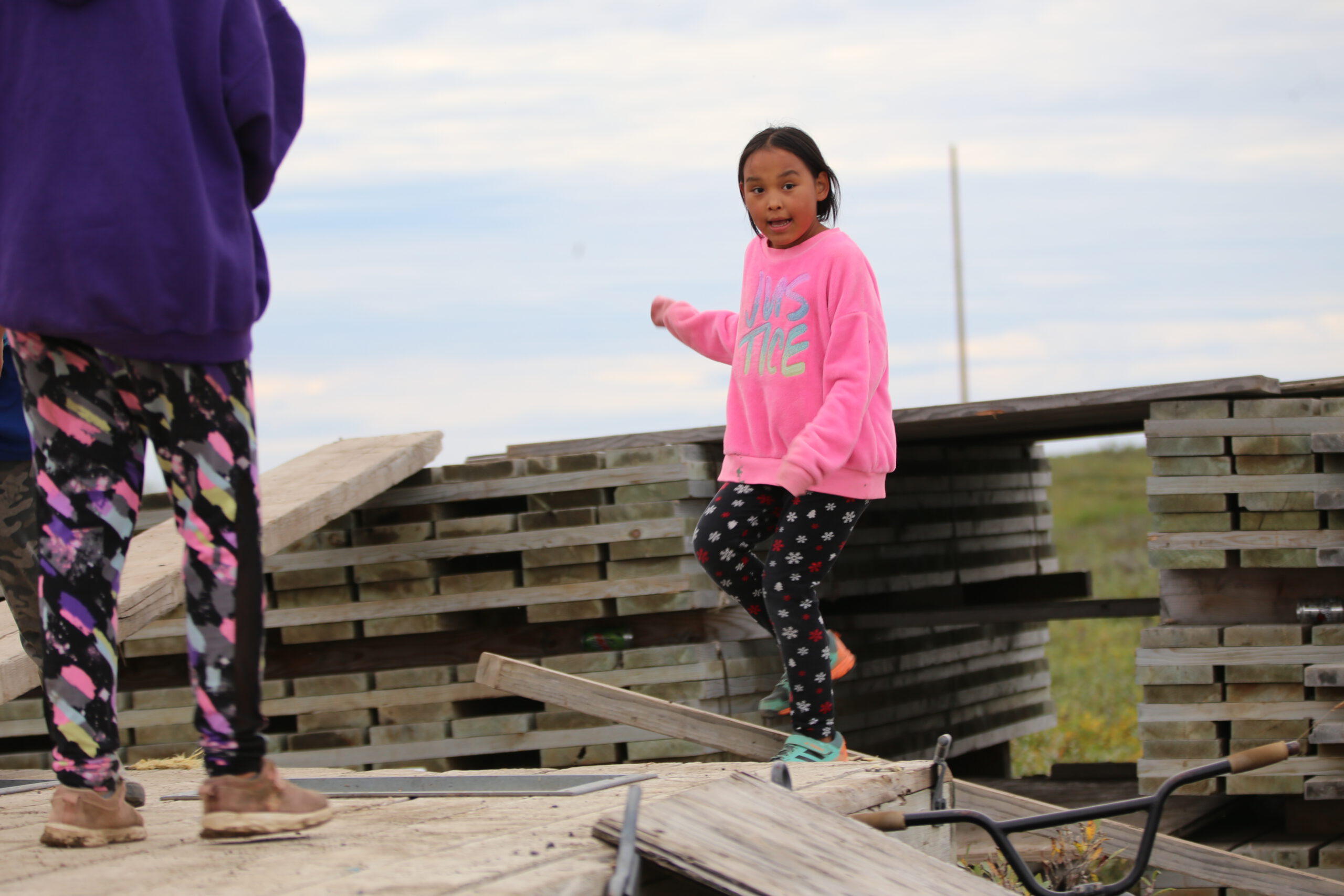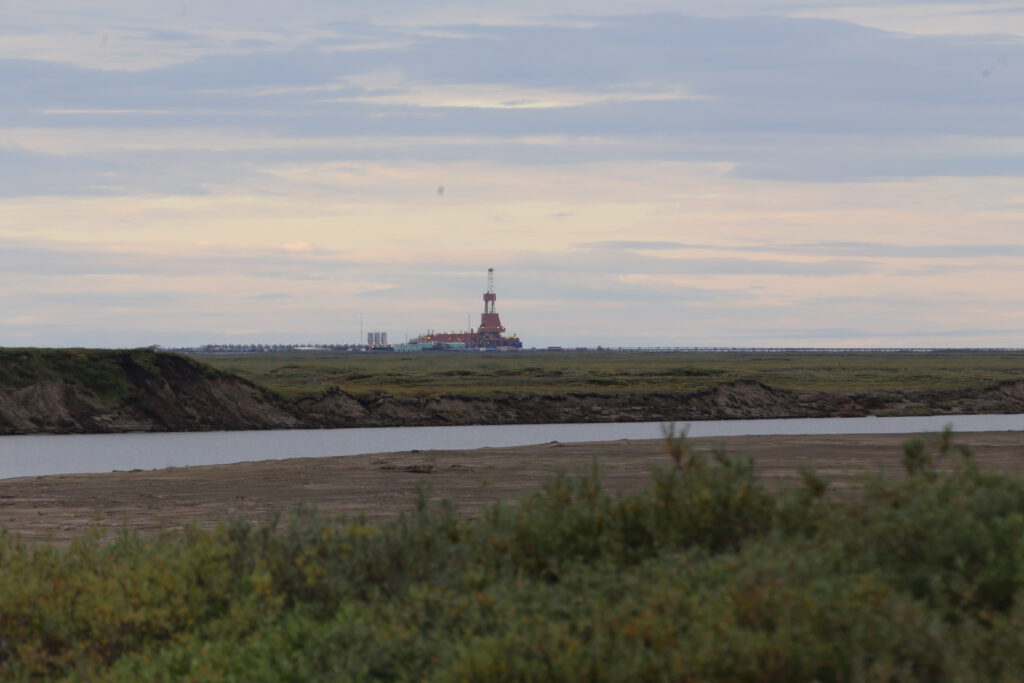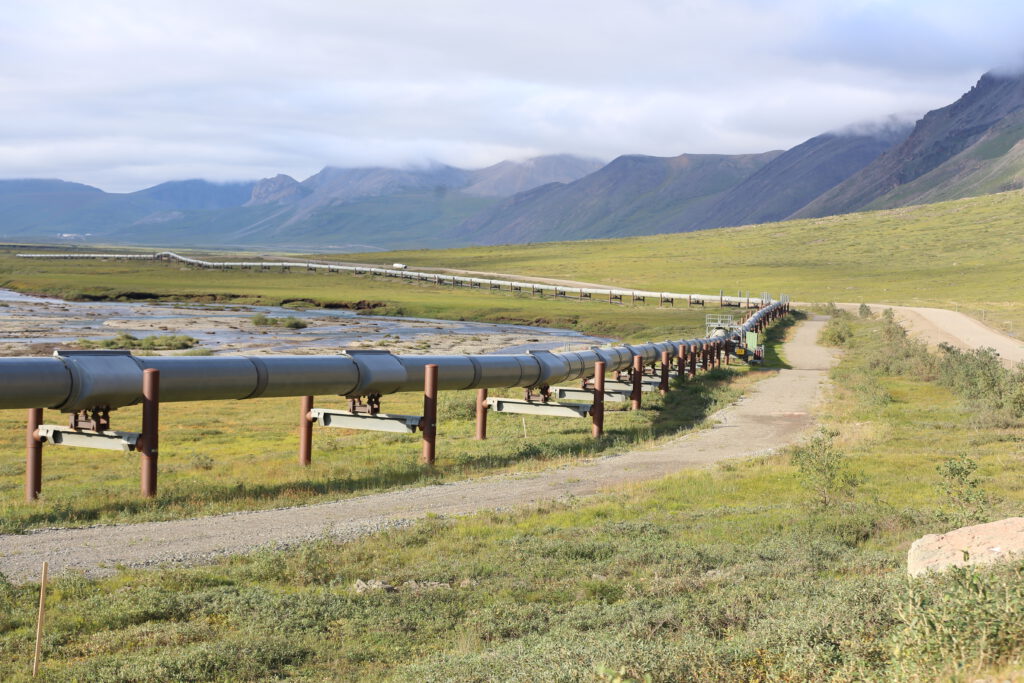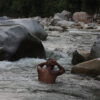By Inga Dreyer and David Schmidt from Nuiqsut
A German version of this article was published in taz – die Tageszeitung in October 2024.
Updated and translated on August 3rd, 2025.
Jonah’s house stands on stilts. He gestures toward the height of the wooden structure and says, “The ice used to be this thick.” Then the elderly man holds his hands about a meter apart: “Now it’s only this much.” Jonah leans against his porch, smiling, and takes a drag on a cigarette. He’s the captain of a whaling boat docked here in Nuiqsut, an Iñupiat village in northern Alaska. Jonah’s face looks as though the Arctic wind has carved deep furrows into it. “Climate change is real,” he says.
Few places on Earth show the effects of the climate crisis as clearly as within the Arctic Circle. In 2023, the University of Alaska Fairbanks reported record-high temperatures in parts of Canada and Alaska—and in 2024, those records were broken again. Only the elders still remember winters with temperatures as low as minus 40 degrees Celsius.
Just 50 years ago, the Indigenous Iñupiat lived a semi-nomadic life in igloos and tents. Today, most are spread across a handful of small communities along the Arctic Ocean coasts of northern Alaska and Canada. One of them is Nuiqsut.
This village of 500 people sits like an island amid the tundra in one of the most sparsely populated regions in the world. Those arriving in August by one of the small planes see the midnight sun reflecting off countless meltwater ponds scarring the landscape. In the dark winter, freezing temperatures turn the land into a white expanse.
In the summer of 2023, when taz visits Jonah, it’s relatively warm by Nuiqsut standards, just under 10 degrees Celsius. Jonah is part of the village’s founding generation. His parents traveled through the Arctic with him, following the migration routes of animals. In the 1970s, their community set up a tent village. Around the same time, the oil industry discovered northern Alaska—the so-called North Slope. Jonah was twelve then.
Wariness Toward the Media
Only one road leads out of Nuiqsut—to the nearby oil field marked by a massive red steel tower rising from the treeless plain. Jonah can see it clearly from his house: the „Alpine Project.“ Nearby, the much larger „Willow Project“ is being developed.
Willow is set to become the largest oil project in Alaska’s history—potentially funneling $8 to $17 billion into state coffers, the local district, and nearby Indigenous communities over its lifetime, according to the developer. The smaller Alpine Project has been operating since the 2000s. Both are run by ConocoPhillips, the world’s seventh-largest oil company. In Germany, the UK, Austria, and Switzerland, a ConocoPhillips subsidiary runs the JET network of gas stations.
Jonah enjoys talking about whaling but avoids discussing the oil industry. He doesn’t want to give his full name. Others in the village feel similarly. There’s widespread suspicion of the media. The Willow Project has turned the village into the stage for a national climate controversy, dividing the community.
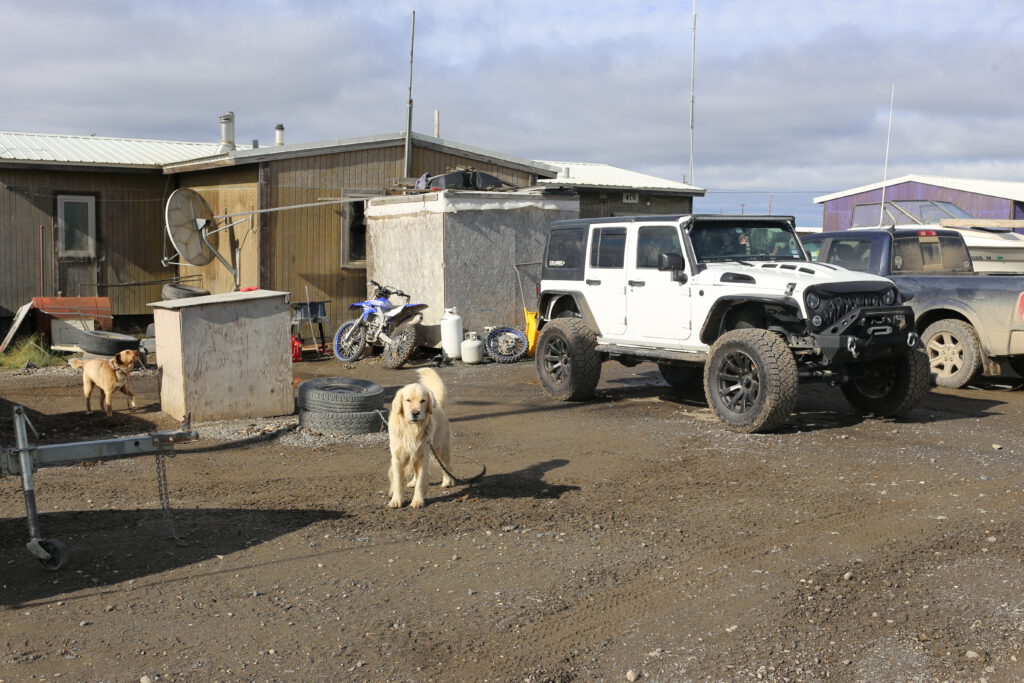
Nuiqsut consists of five blocks of houses, a school, town hall, two churches, a clinic, a heating plant, and a community hall. The flat homes have wood-paneled walls and few windows, raised high on stilts above the soggy permafrost. Scattered around are old car wrecks, new Jeeps, boats, antlers and bones, snowmobiles, trampolines, toys, harpoons, and animal pelts drying on racks. Large green trash bins at every intersection bear colorful artwork and messages: “Welcome to Nuiqsut,” reads one. Another says, “No drugs, no alcohol, no abuse,” signed: “The children of Nuiqsut.” Teenagers roar down the gravel road on loud motorbikes. Beyond the settlement, in every direction, lies endless tundra.
At the village’s edge is a work camp with machinery. Blue oil barrels mark the path. Not far away, ConocoPhillips is building pipelines, airstrips, and other infrastructure. In summer, the permafrost recedes several meters into the earth, leaving behind a spongy, hard-to-navigate terrain. The heavy equipment required for construction can only operate when the ground is frozen. Then roads are carved into the ice, which vanish again with the spring melt.
“The Old Hunting Grounds Are Disappearing”
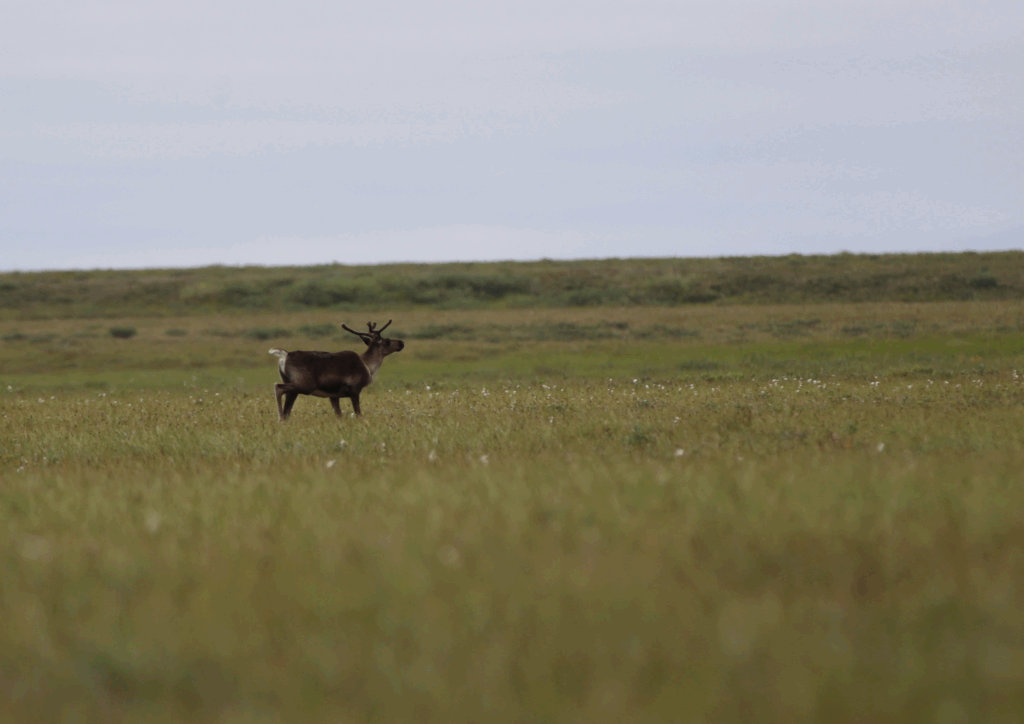
Opponents call the Willow Project a „carbon bomb“—a government analysis estimates it would produce about 280 million metric tons of greenhouse gases over its lifetime. That’s more than one billion flights from Berlin to Munich.
When the Biden administration approved Willow in spring 2023, it sparked a national climate policy debate. Although Biden passed legislation for a climate-friendly transition, he did little to curb fossil fuel production. In recent years, oil drilling has surged to record levels. In response to protests, Biden restricted drilling in Alaska—but Willow was allowed to proceed. If Donald Trump wins the presidency in November, Democratic regulations could be rolled back.
Bridget Psarianos, a lawyer with Trustees for Alaska, represents a coalition of Indigenous and environmental groups suing to stop Willow. The lawsuit claims that the Bureau of Land Management and other agencies violated environmental laws and subsistence rights. “Traffic, noise, and pollution will severely impact wildlife, air and water quality, soil, and the people who live there,” Psarianos says.
Those concerns were echoed in an open letter signed in early 2023 by Rosemary Ahtuangaruak, then mayor of Nuiqsut. Helicopters and construction activities would scare away caribou herds, the letter warned. Yet local officials are now tight-lipped. The town hall and city council declined to comment, and emails to elected officials went unanswered.
The letter came from a building marked “Native Village.” Inside, three women, a baby, and a curious toddler. Eunice Brower, an employee of the Native Village organization and an environmental expert, sits behind a desk piled with papers. “I don’t have time,” she says—then starts talking anyway.
“At first, many people opposed Willow because of its impact on caribou hunting.” The community held repeated discussions among themselves and with ConocoPhillips. Experience with Alpine had shown that drilling platforms affect caribou migration routes, Brower says. “Some elders say the old hunting grounds are disappearing.”
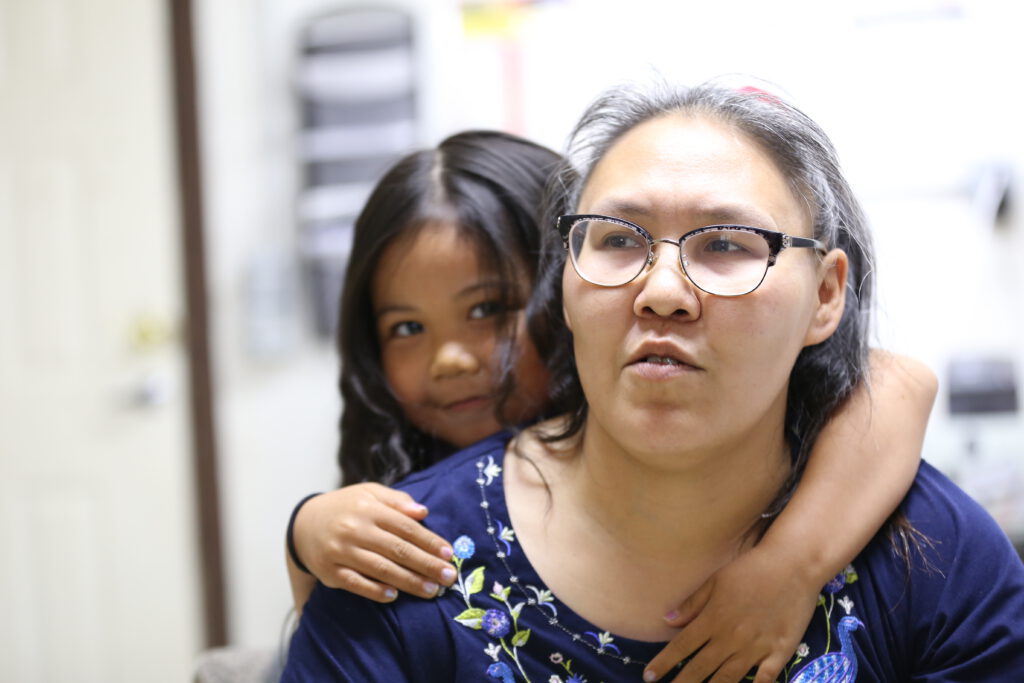
That’s a major issue for local food supply. “On the other hand, many people support Willow because it creates jobs. It brings in a lot of money for the entire North Slope. The infrastructure is outdated, and the money helps to improve it,” she says.
The Old Ways of Sharing Still Hold
The land’s resources don’t belong to the Indigenous people. The National Petroleum Reserve of Alaska is state-owned, but Indigenous corporations hold certain rights. In Alpine’s case, surface rights—entitling them to royalties from ConocoPhillips. Indigenous shareholders, mainly founding families like Jonah’s, receive dividends from the profits.
Kuukpik, the corporation managing these interests, is one of more than 200 “village corporations” representing Alaska’s Indigenous communities. These companies stem from the Alaska Native Claims Settlement Act (ANCSA) of 1971, a law settling land claims during the early oil boom. Indigenous people gave up land claims in exchange for shares in corporations that manage roughly one-tenth of Alaska’s territory.
“Despite the oil profits, much of our community still relies on subsistence,” says Brower. “We hunt fish, whales, seals, bearded seals. Caribou is our main food year-round. But most people eat a lot of whale—the largest animal we live off.”
As Brower checks the clock, an employee leaves for the day. She wears a sweatshirt with the name of Nuiqsut’s women’s whaling crew. In a few days, the boats will head out—across the broad river to a small island in the Arctic Ocean, where the hunt begins.
When the whalers return, food is shared in the traditional way. Even those who can’t work are provided for. Two whales are enough to feed the small community for a year. In the past, failed hunts could mean hunger—and even senicide, where elders were left behind so the rest could move faster and eat more. Such hardships were often triggered by industrial-scale depletion of animal stocks—by Russia, the U.S., and Europe. Whaling fleets brought the bowhead whale close to extinction by the early 20th century. Whaling has been banned in the U.S. since 1972, with limited exceptions for Indigenous people.
Fears of Health Consequences
Rosemary Ahtuangaruak has long criticized the oil industry. In summer 2023, still mayor of Nuiqsut, it was already clear it would be her last term. Discontent was brewing—partly because she was one of the few publicly opposing Willow. But she won’t talk. “Go to Sam and Rene,” she says on the phone, gives an address—and the line cuts out.
Sam Kunaknana and Rene Opie’s house has a small entryway with a freezer full of caribou meat, salmon, and grayling. Kunaknana, in his mid-50s with salt-and-pepper hair, sits on a chair with his legs crossed. In a soft voice, he talks about hunting and activism. He’s been on the tribal council and served as mayor. “No one here knows more about our land and animals,” says Rene. The two no longer get jobs—Kunaknana suspects it’s because of his stance on Willow.
“Many people don’t understand what’s really happening here,” he says. He’s warned for years about the impact of drilling on Iñupiat life. He’s worried about caribou—but also about health effects.
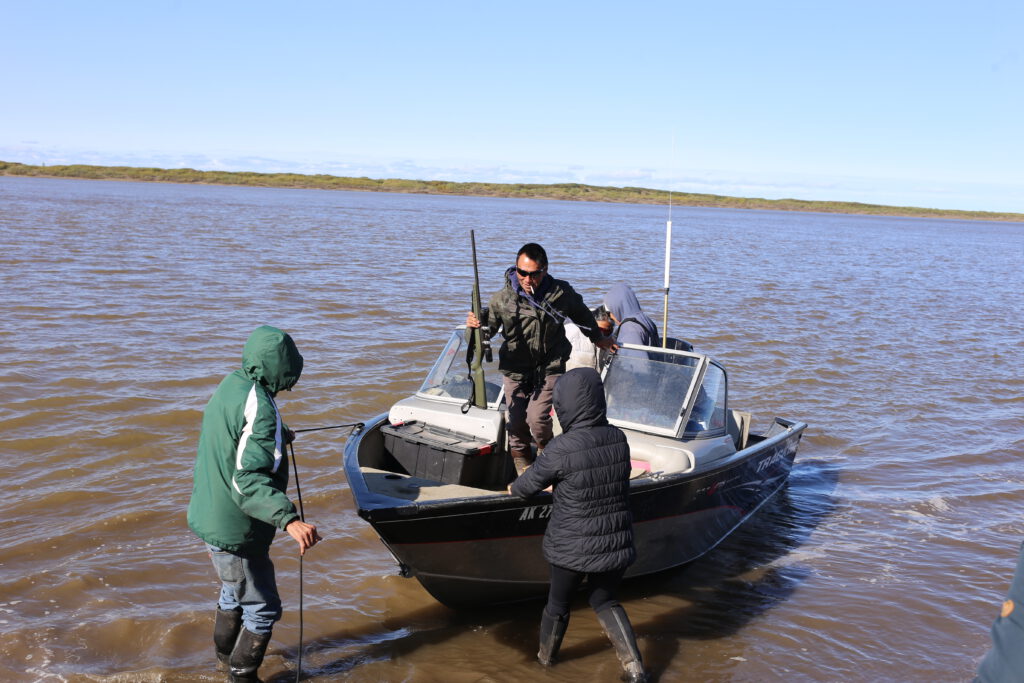
The next day, the couple packs bags of smoked salmon and dried meat. They head north by motorboat to traditional Iñupiat hunting grounds. A young woman with facial tattoos goes with them.
Kunaknana moors the boat, climbs a slope, and ties a white piece of plastic to a branch—to help them find the spot later. Then he slings a rifle over his shoulder, pushes willow branches aside, and picks a path through the brush.
“Many Young Indigenous People Struggle with Mental Health”
Progress through the tundra is slow; the ground gives way underfoot. If you’re not careful, you’ll step into streams flowing under the shrubs. After a few meters, the willows thin out, revealing a vast plain. The young woman disappears ahead. “She has to be careful. A bear could sneak up,” says Kunaknana. Just then, she reappears: “Wow! Cloudberries!” she exclaims, holding a bag of yellow, overripe fruit.
Qapqan Patkotak is 18 and lives in Utqiagvik, Alaska’s largest Iñupiat settlement. She’s spending her school break in Nuiqsut. As Kunaknana scans the horizon, she wanders off, searching for berries.
She begins to talk. Recently, her friend died. People say she walked alone onto the ice and drifted away on a floe. Maybe it was suicide.
Then she speaks of her parents’ traumas and how they’re passed down. “Many young Indigenous people struggle with their mental health. Some suffer so much that it leads to suicide.” Because elders don’t talk about the crimes of their childhood, many youth don’t know the roots of their pain. Schools don’t teach about it either. “They just feel something’s wrong. We have a lot of alcoholism, drug abuse—everything you can imagine.”
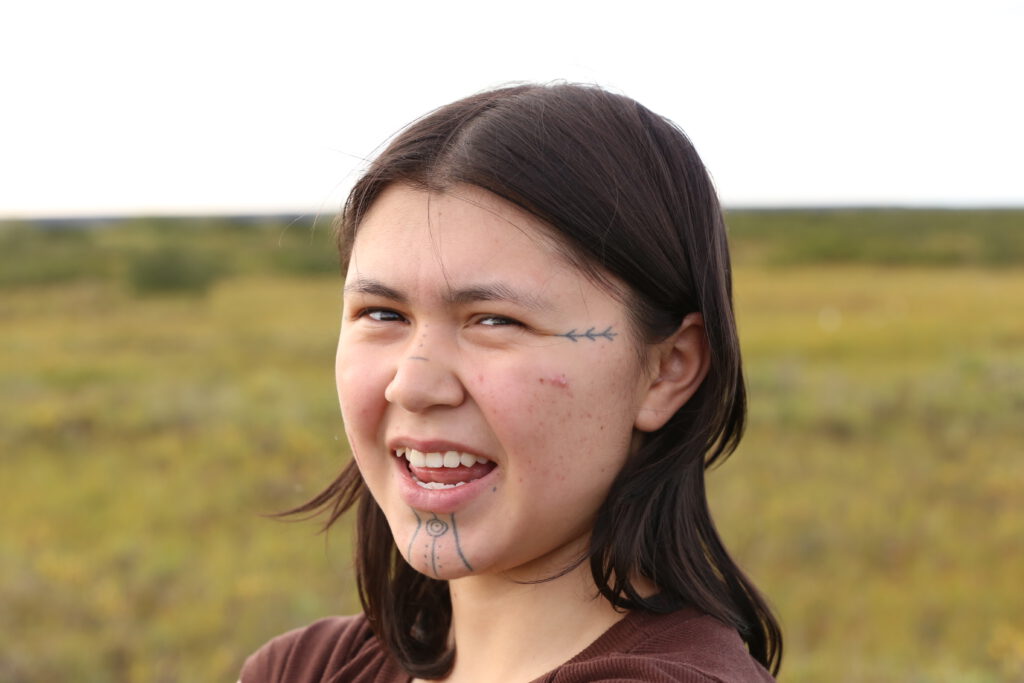
Oil Is a “Blessing and a Curse”
In the U.S. and Canada, until the 1960s, Christian boarding schools aimed to break up Indigenous communities and take their land. According to investigations and first-person accounts, children were taken from their families, forced into schools, and often severely abused. They were given English names. Their Indigenous names, languages, and spiritual practices were banned under penalty. Violence, humiliation, and abuse were common. Tens of thousands are still missing.
The Arctic has some of the world’s highest suicide rates—Indigenous people are especially affected. “I’ve heard the stories from those who were in the boarding schools,” says Patkotak. “They were treated horribly. That goes for all Native people in Alaska and the U.S.”
She wants Indigenous people to return to their traditional way of life. “But how do we bring it back? There are language classes for Iñupiaq, but much of our culture has been lost—especially our spirituality.”
She has a clear opinion on Willow: “The corporations only care about profits. I wish they’d just go away.” But few people think like her.
Sam Kunaknana calls the oil industry “a blessing and a curse.” The money helps—but without action, the Iñupiat culture could vanish.

The Youth Don’t Know What a Real Caribou Herd Looks Like
Amy Lovecraft, a political scientist at the University of Alaska Fairbanks, speaks of a generational conflict: while younger people want to move away from fossil fuels, many elders once fought for land rights and are proud of the current system. That makes change difficult. “But I’ve seen young people speak up at meetings,” she says.
The city council and Native Village have since distanced themselves from their open letter and criticism of Willow. In August 2024, ConocoPhillips announced that major milestones had been reached and construction was ahead of schedule. Alaska is deeply conservative and lacks a state-level climate policy—even as the land changes rapidly.
Ice is retreating. Permafrost is melting, according to biologist Nancy Fresco. “If the ground isn’t frozen anymore, storms cause heavy erosion.” Vegetation is changing. The deeper the thaw layer, the larger the plants. While much of Alaska is forested with spruce, the tundra hosts low-rooted shrubs, mosses, and grasses. “Even slight surface changes can push more shrubs and trees northward,” Fresco says. “One thing’s certain: there will be a new Arctic.”

Sam Kunaknana scans the tundra, raises his rifle. A lone caribou is in the distance. He aims carefully—then lowers the gun. He lets the caribou go. “It’s too big. The elders wanted a young, tender one,” he says.
Young people today, he says, don’t know what a real caribou herd looks like. “They see a few hundred and think that’s a lot.” But back then, the herds were enormous. “It was like the whole tundra was moving.”
Notes
Translated into English from the original German by Carl Roberts. This article was researched and written with support from the Heinrich Böll Foundation, Washington, DC’s Transatlantic Media Fellowship.
Update: Since the time of this article’s writing, Donald Trump became president of the United States and quickly shifted national policy on fossil fuel extraction in Alaska: https://www.highnorthnews.com/en/trump-signs-order-maximize-resource-development-alaska.
On August 3, 2025, the U.S. Department of the Interior rescinded protections introduced under President Biden for parts of Alaska’s North Slope. The move withdraws the „Special Area Policies“ within the National Petroleum Reserve, potentially opening previously safeguarded regions to expanded oil and gas development: https://www.doi.gov/pressreleases/interior-withdraws-restrictive-special-area-policies-alaskas-national-petroleum.

